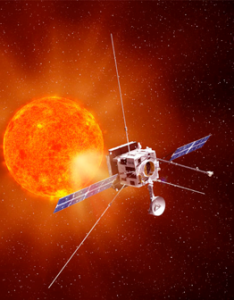Nov 4 2013
SRI International, working with specialty foundry leader TowerJazz, has delivered the first complementary metal-oxide semiconductor (CMOS) imager engineering units to the Naval Research Laboratory (NRL) for use on the Solar Orbiter Heliospheric Imager (SoloHI) optical telescope. With its large field of view, SoloHI will make high-resolution images of the corona and solar wind and be able to connect remote sensing observations of the corona to the plasma being measured in situ at the spacecraft.
 Artist's conception of the Solar Orbiter spacecraft. (Illustration: NASA)
Artist's conception of the Solar Orbiter spacecraft. (Illustration: NASA)
SoloHI is part of the NASA and European Space Agency (ESA) Solar Orbiter mission. Planned for launch from Cape Canaveral Air Force Station, Florida in 2017, the spacecraft is expected to study the sun from a closer distance than any previous mission.
The Solar Orbiter mission will be the first time that such a large format CMOS detector has flown. SoloHI’s measurements will allow scientists to identify space weather events such as coronal mass ejections (CMEs). CMEs can affect electromagnetic fields on earth impacting power lines, satellite communications and cell phone service.
“This first delivery of our SoloHI high-performance CMOS imager technology to NRL for the Solar Orbiter space mission is an important step toward deploying this technology in a wide range of aerospace applications,” said Mark Clifton, vice president, Products and Services at SRI International. “TowerJazz’s radiation-hardened CMOS image sensor manufacturing process helped us achieve this innovative solution.”
The SoloHI imager is a CMOS image sensor (CIS) built using customized 0.18-um CMOS technology. The radiation-hardened 2k x 2k (4-megapixel) CMOS imagers have passed engineering testing by SRI and are now ready for NRL test bed integration. The full-flight SoloHI focal plane will incorporate a mosaic of four imagers providing a 4k x 4k (16-megapixel) format.
The manufacturing platform for the SoloHI CMOS imager is the TowerJazz 0.18-um process running in Newport Beach, California. TowerJazz has been working with SRI for several years to support U.S. government imaging applications by developing custom technology with advanced radiation hardness, optimization for low read-out noise, and tailored for both frontside and backside illumination.
“We are pleased to see our 0.18-um CIS process employed in the NRL flight program through our work with SRI,” said Marco Racanelli, senior vice president and general manager of US Aerospace and Defense Business Group at TowerJazz. “The CIS process is the latest example of our strong commitment to innovative manufacturing technology in the U.S. for the use of our space and government related customers.”